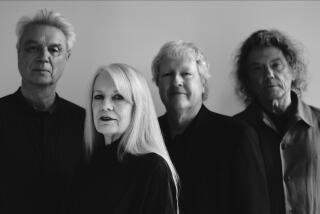O.C. POP MUSIC REVIEW : For What It’s Worth--Stills Is Not a Dinosaur
- Share via
SAN JUAN CAPISTRANO — “Here is an old, old song from the Jurassic Age of rock ‘n’ roll,” Stephen Stills said as he launched into the 1967 Buffalo Springfield hit, “For What It’s Worth” toward the end of his 13-song set at the Coach House.
Stills wrote the song to express the political discontent of the ‘60s, and he could have easily presented it Saturday as relevant to today’s troubling times. Instead, he turned it into a merry audience participation tune in which he sang “Stop,” the crowd shouted back “Hey!” and he replied “What’s that sound?” Could a performer as fiercely independent as a Stephen Stills really have degenerated into an oldies act?
Not quite.
Stills presented enough new material and fresh twists on old hits to refute the notion that he was merely cashing in on nostalgia. Even though his concert wasn’t a mere relic of the Jurassic, however, it wasn’t much beyond the Pleistocene, either.
The high points of his 80-minute set relied heavily on the fond memories that his fans hold for the Crosby, Stills & Nash legacy. “Southern Cross,” Stills’ hit from the trio’s 1982 comeback album “Daylight Again,” was the most requested and most enthusiastically received number of the evening, and his solo hits from the early ‘70s also drew big ovations.
Even when Stills wasn’t recycling CS&N; classics or his own ‘70s vintage solo material, he tended to turn to the ‘60s for inspiration. The most powerful numbers in his set were his searing versions of Paul Butterfield’s “Born in Chicago” and Albert King’s “Born Under a Bad Sign.”
On the latter number, Stills demonstrated his proficiency of blues guitar while his longtime keyboards player Mike Finnigan handled the vocals. Still’s guitar playing, particularly on the two blues numbers, provided most of the fireworks in Saturday’s set.
Selecting instruments from an onstage guitar collection that included a Telecaster, Gibson SG, Flying V and acoustic guitar, Stills attacked each number with a verve that added life and texture to every song. Often Stills traded leads with Finnigan and the dual assault of guitar and keyboards prodded some new life into old songs.
Stills’ once-supple voice is somewhat the worse for wear, but he partially compensated for his decreased vocal range by the intensity of his singing. On some numbers, such as “Love the One You’re With” and “Woodstock,” Stills’ coarser, grittier vocals tended to add dimension to overly familiar material.
On other songs, however, such as the more delicate “Change Partners,” his singing simply fell short.
Though the primary reference point for the show was Stills’ glory years in the late ‘60s and early ‘70s, the evening was not entirely a rehash of the past.
On “Amazonia,” Stills made innovative use of Latin American rhythms and he addressed the critical environmental issue of destruction of the rain forests. If Stills would challenge his audience more in that way rather than relying on his past triumphs, he might yet avoid ending up as another dinosaur on the oldies circuit.
*
Throughout her seven-song set, opener Susan James combined her multi-octave voice, unusual guitar stylings and expressive songwriting to create richly textured numbers in which her voice and guitar dramatized the lyrics. For example, on her original song, “From Across the Sea,” she lowered the volume of her voice and moved away from the microphone to convey a feeling of distance.
The San Francisco performer announced that she was going to perform her version of the Byrds’ 1966 hit, “Eight Miles High.” Her rendition, however, was so original and so different from the Byrds’ that if she hadn’t mentioned the title, many may not have recognized it. In contrast to the jangly guitar chords characteristic of the Byrds, James used percussive plucking of single strings on the neck of her guitar to give the number an almost aboriginal sound.
During her 40-minute set, James accomplished the remarkable feat of drawing repeated ovations for unfamiliar and highly innovative material from Stills’ partisan crowd.
More to Read
The biggest entertainment stories
Get our big stories about Hollywood, film, television, music, arts, culture and more right in your inbox as soon as they publish.
You may occasionally receive promotional content from the Los Angeles Times.










